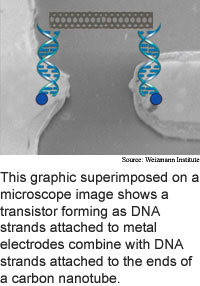
DNA makes nanotube transistors
Researchers from the Weizmann Institute
of Science in Israel have harnessed the self-assembly abilities of DNA
to construct field-effect transistors from carbon nanotubes.
Carbon nanotubes are rolled-up sheets of carbon atoms that can
be narrower than one nanometer, which is the span of 10 hydrogen atoms.
DNA is made of four types of bases -- adenine, cytosine, guanine and thymine
-- connected to a sugar-phosphate backbone. Bases on single strands of
DNA pair up to form the familiar double helix of biological DNA. Artificial
stretches of DNA can be engineered so that stretches of DNA combine to
form structures. DNA can also be engineered to connect to objects like
carbon nanotubes.
The researchers attached DNA strands to carbon nanotubes and complementary
strands to gold electrodes that were anchored to a silicon surface. The
electrodes were prepared using standard chip-making techniques. They mixed
a liquid containing the DNA-coated nanotubes with the silicon, and the
complementary DNA strands combined, placing the nanotubes across pairs
of electrodes.
The transistors could eventually be used in small, fast computer
circuits. The researchers' method promises to scale up to suit mass-production
requirements. The method could allow for real-time modifications of the
electrical behavior of the devices by introducing biological molecules
capable of interacting with the DNA, according to the researchers.
The method yields transistors for about 10 percent of the electrode
pairs, according to the researchers. They are working on improving the
yield by modifying the degree and location of DNA coverage of the carbon
nanotubes.
Other researchers have recently use more complicated processes
to coax DNA to assemble carbon nanotube transistors, but these are less
suited to mass fabrication, according to the researchers.
The Weizmann method could be used to fabricate practical transistors
in two to five years, according to the researchers. The work appeared
in the November 22, 2004 issue of Applied Physics Letters.
Light clock promises finer time
Physics model predicts book sales
Silicon ring boosts light chips
Molecule harvests water's hydrogen
Briefs:
Virtual ring eases scrolling
DNA makes nanotube transistors
Scheme simplifies quantum chips
Aligned nanotubes accommodate bone
Light writes info into atoms
See-through circuits speed up

Research Watch blog
View from the High Ground Q&A
How It Works
RSS Feeds:
News
Ad links:
Buy an ad link
Ad links: Clear History
Buy an ad link
|
TRN
Newswire and Headline Feeds for Web sites
|
© Copyright Technology Research News, LLC 2000-2010. All rights reserved.